LG Bundle
Can LG Maintain Its Momentum in a Rapidly Changing World?
LG Corp., a global leader in electronics, chemicals, and telecommunications, has consistently demonstrated the importance of a strong growth strategy. From its pioneering efforts in the OLED television market to its diverse portfolio of innovative products, LG's journey reflects a commitment to shaping consumer expectations. Founded in 1947, LG has transformed from a chemical company to a global powerhouse, showcasing its adaptability and vision.
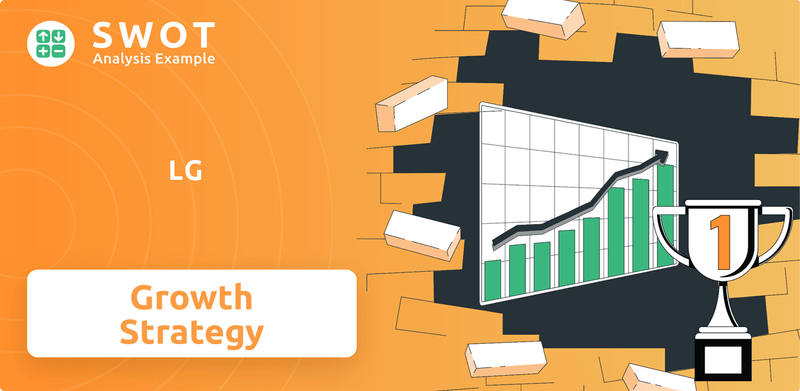
This article delves into LG's ambitious plans for the future, exploring its LG SWOT Analysis to understand its competitive position. We'll examine how LG's strategic expansion, technological innovation, and meticulous planning are poised to drive future growth. Analyzing LG's business model and market share will reveal key insights into its strategies for navigating the dynamic consumer electronics market and achieving its long-term vision.
How Is LG Expanding Its Reach?
The Marketing Strategy of LG involves a multifaceted approach to expansion, focusing on both market penetration and diversification. LG's growth strategy is centered on strengthening its existing business segments while investing in new, high-growth areas. This strategy aims to enhance LG's market share and secure its future prospects in a rapidly evolving technological landscape.
LG's future prospects are closely tied to its ability to adapt to changing consumer preferences and technological advancements. The company is actively exploring new business models and leveraging partnerships to foster growth. By focusing on innovation and sustainability, LG aims to maintain its competitive edge in the global market.
LG's expansion initiatives are designed to broaden its market reach and diversify its revenue streams. The company is targeting significant growth in key areas such as B2B, EV charging solutions, and emerging technologies like robotics and AI services. These strategic moves reflect LG's commitment to long-term growth and its vision for the future.
LG is significantly strengthening its business-to-business (B2B) operations, particularly in commercial displays and system air conditioners. The company aims to increase its B2B sales to 30% of total sales by 2030. This expansion includes entering new geographical markets for HVAC solutions, with a focus on North America and Europe.
LG is expanding its electric vehicle (EV) charging solution business. Plans include building EV charger production lines in the United States by the first half of 2024. This move demonstrates LG's commitment to the growing EV infrastructure market, capitalizing on the increasing demand for EV charging solutions.
LG is investing in new product categories such as robotics and artificial intelligence (AI) services. The goal is to integrate these technologies across its existing product lines and develop new business models. LG is exploring the robot service market, developing various robot solutions, including guide robots and serving robots.
LG is focusing on expanding its presence in key markets. This includes entering new geographical markets for its HVAC solutions, with a particular emphasis on North America and Europe. These strategic moves are part of LG's broader strategy to enhance its global footprint and drive revenue growth.
LG's expansion strategy focuses on several key areas to drive growth and capitalize on emerging opportunities. This includes a strong emphasis on B2B markets, EV charging solutions, and the integration of robotics and AI.
- B2B Focus: Targeting commercial displays and system air conditioners. Aiming for 30% of total sales by 2030.
- EV Charging: Building EV charger production lines in the U.S. by the first half of 2024.
- Robotics and AI: Developing robot solutions like guide and serving robots for commercialization.
- Geographic Expansion: Entering new markets in North America and Europe for HVAC solutions.
LG SWOT Analysis
- Complete SWOT Breakdown
- Fully Customizable
- Editable in Excel & Word
- Professional Formatting
- Investor-Ready Format
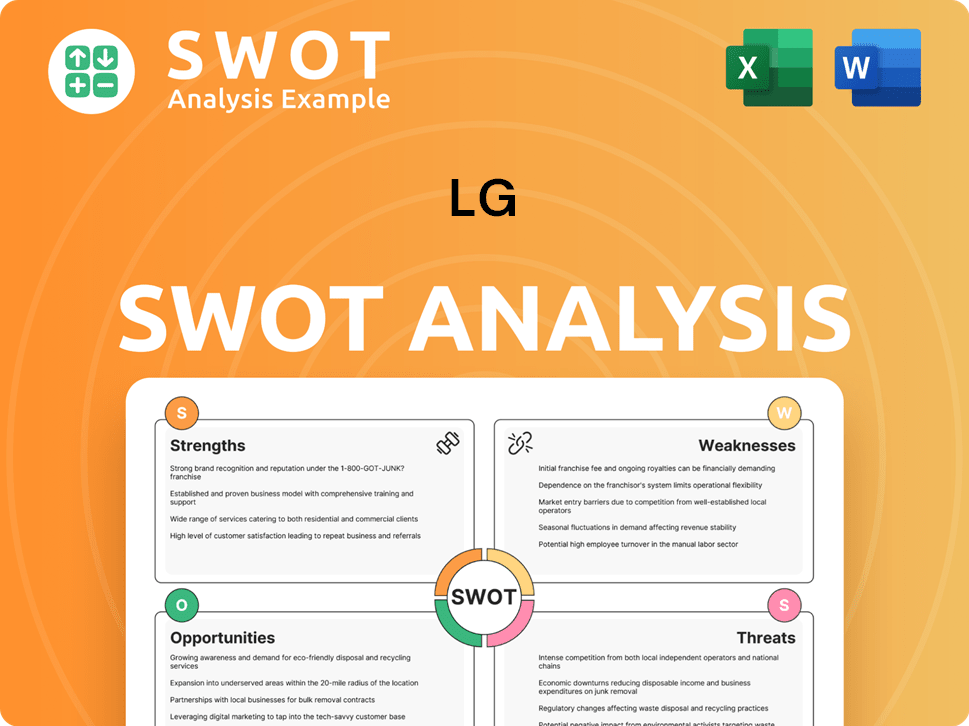
How Does LG Invest in Innovation?
The company strategically leverages technology and innovation as key drivers for its sustained growth. This strategy is underpinned by substantial investments in research and development and the formation of strategic collaborations. The company's commitment to innovation is evident in its consistent pursuit of patents across its diverse business segments, solidifying its leadership in various technological domains.
In 2024, the company showcased its dedication to artificial intelligence (AI) through its 'AI for a Better Life' vision at CES. This included the unveiling of its new AI platform, 'AlphaWare,' designed to integrate AI across its product portfolio, spanning from home appliances to mobility solutions. The company is focused on developing on-device AI capabilities, allowing products to perform tasks and adapt to user needs without constant cloud connectivity, enhancing both privacy and responsiveness.
Furthermore, the company's innovation strategy extends to sustainability, with ongoing efforts to develop energy-efficient products and reduce its environmental footprint. For instance, the company is actively researching and implementing technologies for improved energy efficiency in its home appliances and air conditioning systems. The company also continues to lead in display technology, with ongoing advancements in its OLED panels, and is exploring new applications for augmented reality (AR) and virtual reality (VR) technologies. For more insights, you can explore the perspective of Owners & Shareholders of LG.
The 'AlphaWare' platform is designed to integrate AI across various products. This includes home appliances and mobility solutions, enhancing user experience and product functionality. On-device AI capabilities are a key focus, enhancing privacy and responsiveness.
The company is actively developing energy-efficient products and reducing its environmental footprint. Research and implementation of energy-efficient technologies in home appliances and air conditioning systems are ongoing. This reflects a commitment to sustainable practices.
The company continues to lead in display technology, particularly with its OLED panels. Ongoing advancements in OLED technology are a key area of focus. Exploring new applications for AR and VR technologies is also underway.
Significant investments in research and development are a cornerstone of the company's strategy. These investments support the development of new technologies and product innovations. Strategic collaborations further enhance R&D efforts.
Consistent filing of patents across diverse business segments solidifies its leadership. This demonstrates a commitment to protecting its intellectual property. Patent filings reflect the company's innovation efforts.
The company actively forms strategic collaborations to enhance its innovation capabilities. These partnerships support the development and deployment of new technologies. Collaborations help expand market reach and expertise.
The company's focus on innovation is evident in its key technological advancements and strategic initiatives. These advancements are crucial for its future prospects and maintaining a competitive edge in the market. The company's investment in AI, sustainability, and display technology are significant.
- AI for a Better Life: The 'AI for a Better Life' vision is central to the company's strategy.
- AlphaWare Platform: This platform integrates AI across various product lines.
- Energy Efficiency: Ongoing efforts to improve energy efficiency in home appliances.
- OLED Technology: Continued advancements in OLED panel technology.
LG PESTLE Analysis
- Covers All 6 PESTLE Categories
- No Research Needed – Save Hours of Work
- Built by Experts, Trusted by Consultants
- Instant Download, Ready to Use
- 100% Editable, Fully Customizable
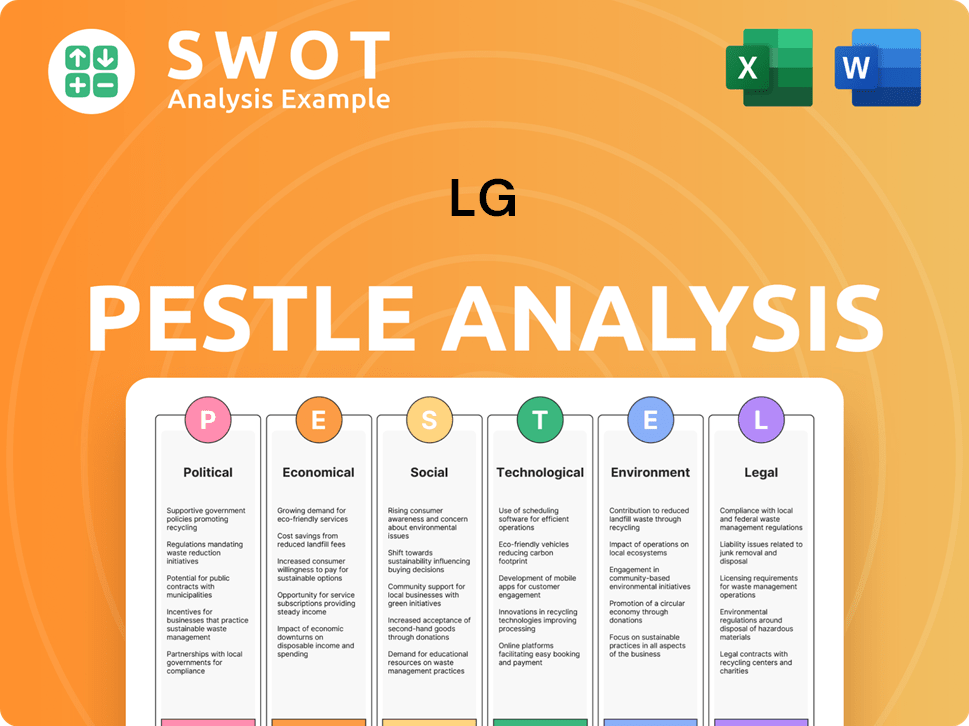
What Is LG’s Growth Forecast?
The financial outlook for LG is shaped by its ambitious growth strategies, focusing on increasing profitability and expanding its market share across core business segments. The company's performance in the first quarter of 2024 provides a clear indication of its current trajectory and future potential. Strategic investments in emerging technologies and expansion into new markets are key drivers of its long-term financial health.
In the first quarter of 2024, LG Electronics reported consolidated revenues of KRW 21.09 trillion, with an operating profit of KRW 1.33 trillion. The Home Appliance & Air Solution (H&A) Company achieved record-high first-quarter revenues of KRW 8.60 trillion, driven by strong sales of air conditioning and heat pump products. The Vehicle component Solutions (VS) Company also recorded its highest first-quarter revenues at KRW 2.66 trillion, indicating robust growth in the automotive sector. These figures highlight the company's strong performance and its ability to generate substantial revenue across various sectors.
LG's strategy involves enhancing its business structure by expanding B2B operations and accelerating platform-based service businesses. These initiatives are expected to contribute significantly to future revenue and profit margins. Furthermore, the company is actively investing in future growth engines, such as EV charging solutions and digital healthcare, allocating capital to R&D and strategic acquisitions to support these initiatives. For a deeper understanding of LG's business model and revenue streams, you can explore the insights provided in Revenue Streams & Business Model of LG.
LG's growth strategy in consumer electronics focuses on premium products and innovative technologies. This includes a strong emphasis on OLED TVs, advanced home appliances, and smart home integration. The company aims to maintain its market share and drive revenue growth through continuous innovation and enhanced customer experiences.
The future prospects for LG's OLED TV technology are promising, with increasing demand for high-quality displays. LG is investing in R&D to enhance OLED technology, improve picture quality, and expand its product range. The company is also exploring new applications for OLED, such as transparent displays and rollable TVs.
LG is expanding its presence in the electric vehicle components sector, leveraging its expertise in batteries, displays, and other technologies. This includes partnerships with major automotive manufacturers and investments in production capacity. The company aims to capture a significant share of the growing EV market.
LG is adapting to changing consumer preferences by focusing on smart home solutions, personalized products, and sustainable practices. This involves developing user-friendly interfaces, energy-efficient appliances, and eco-friendly packaging. The company is also investing in digital services to enhance customer engagement.
Analyzing LG's financial performance and future outlook involves assessing its revenue growth, profitability, and market share. Key factors include the performance of its core business segments, investments in new technologies, and expansion into emerging markets. The company's ability to innovate and adapt to changing market conditions will be crucial for its long-term success.
- Revenue Growth: Analysts project continued revenue growth in 2025, driven by strong performance in premium home appliances and expanding B2B solutions.
- Profitability: LG aims to improve profit margins through operational efficiencies, cost management, and a focus on high-value products and services.
- Market Share: The company is focused on maintaining and expanding its market share in key segments, such as OLED TVs, home appliances, and automotive components.
- Strategic Investments: LG is investing in R&D, strategic acquisitions, and new technologies to support its growth initiatives and maintain a competitive edge.
LG Business Model Canvas
- Complete 9-Block Business Model Canvas
- Effortlessly Communicate Your Business Strategy
- Investor-Ready BMC Format
- 100% Editable and Customizable
- Clear and Structured Layout
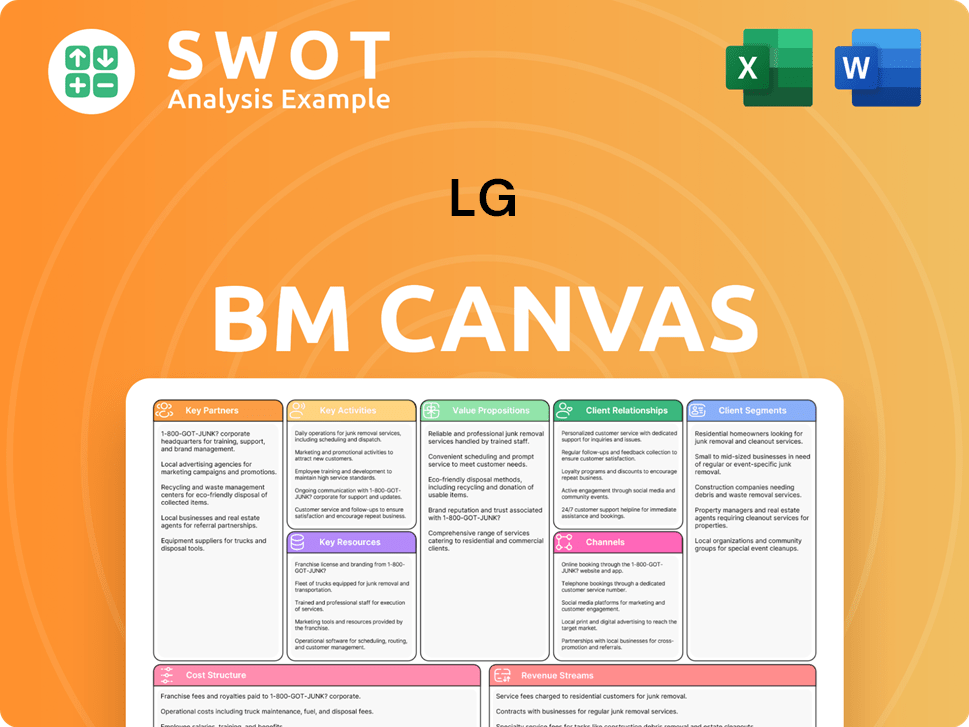
What Risks Could Slow LG’s Growth?
LG's ambitious growth plans face several potential risks and obstacles. The consumer electronics market is fiercely competitive, and regulatory changes, especially regarding environmental standards and data privacy, pose challenges. Global supply chain disruptions and rapid technological advancements also present significant hurdles.
Intense competition from global and regional players can squeeze pricing and profit margins. Furthermore, geopolitical tensions and economic fluctuations add to the uncertainty. To navigate these complexities, LG must continuously adapt its strategies and operations.
As highlighted in an article about the Target Market of LG, understanding consumer preferences is crucial for sustained growth. LG's ability to innovate and respond to market dynamics will be key.
The consumer electronics market is highly competitive, with numerous global and regional players vying for market share. This intense competition can lead to price wars and reduced profit margins, impacting LG's financial performance. LG must continually innovate and differentiate its products to maintain a competitive edge.
Evolving regulatory landscapes, particularly concerning environmental standards and data privacy, require significant adjustments to product design and operational processes. These changes can increase costs and demand compliance efforts. LG needs to proactively adapt to these regulatory shifts to avoid penalties and maintain its market position.
Global supply chain disruptions, as experienced during the COVID-19 pandemic and ongoing geopolitical tensions, remain a persistent threat. These disruptions can impact production, delivery timelines, and overall operational efficiency. LG must invest in robust supply chain management and diversification to mitigate these risks.
The rapid pace of technological advancements poses a risk of obsolescence for LG's products. Staying ahead of the curve requires continuous investment in research and development, and the ability to quickly adapt to new technologies. Failure to innovate can lead to a loss of market share and reduced competitiveness.
Global economic trends, including inflation, interest rate changes, and recessionary pressures, can significantly impact LG's performance. Economic downturns can reduce consumer spending and affect demand for its products. LG must be prepared to navigate these economic uncertainties through strategic financial planning and cost management.
Increasing cybersecurity threats pose a risk to LG's operations and data security. Cyberattacks can disrupt operations, compromise sensitive information, and damage the company's reputation. LG must invest in robust cybersecurity measures to protect its assets and maintain customer trust. In 2024, cyberattacks cost businesses globally an estimated $9.2 trillion.
To mitigate these risks, LG employs a diversified business portfolio, reducing its reliance on any single market or product category. The company invests heavily in risk management frameworks, including scenario planning and robust supply chain management systems. LG actively diversifies its component sourcing and strengthens its logistics networks to enhance supply chain resilience. In 2024, LG's efforts in supply chain optimization led to a 15% reduction in disruptions.
LG focuses on continuous innovation and adaptation to stay competitive. This includes investing in R&D, developing new products, and leveraging emerging technologies like AI and smart home solutions. LG's investment in R&D reached approximately $4.5 billion in 2024. The company also actively seeks partnerships and collaborations to expand its market reach and enhance its technological capabilities.
LG Porter's Five Forces Analysis
- Covers All 5 Competitive Forces in Detail
- Structured for Consultants, Students, and Founders
- 100% Editable in Microsoft Word & Excel
- Instant Digital Download – Use Immediately
- Compatible with Mac & PC – Fully Unlocked
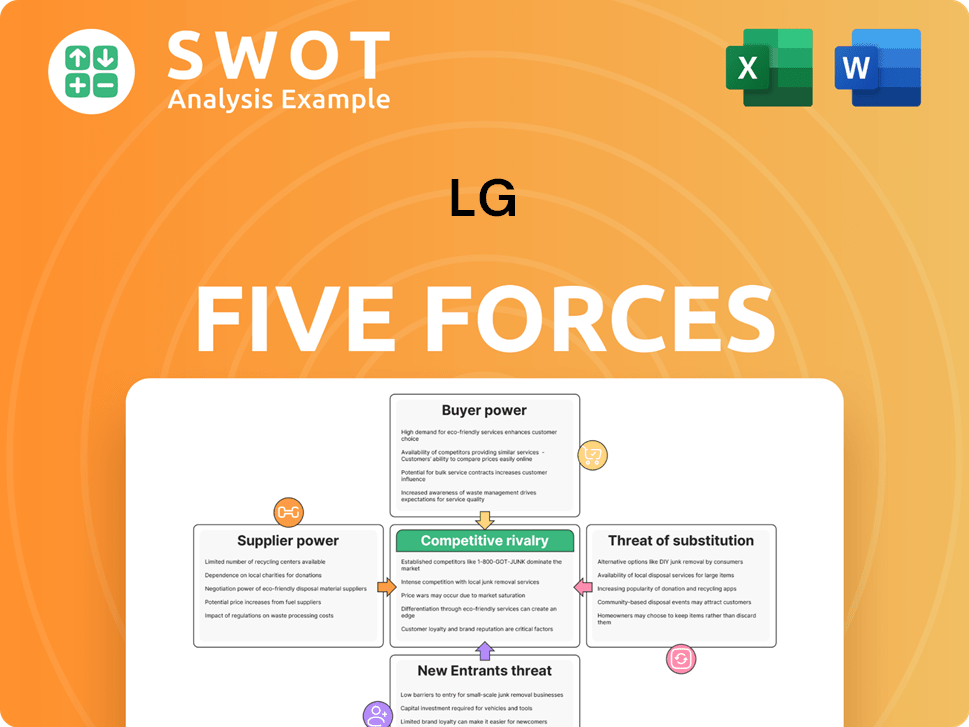
Related Blogs
Disclaimer
All information, articles, and product details provided on this website are for general informational and educational purposes only. We do not claim any ownership over, nor do we intend to infringe upon, any trademarks, copyrights, logos, brand names, or other intellectual property mentioned or depicted on this site. Such intellectual property remains the property of its respective owners, and any references here are made solely for identification or informational purposes, without implying any affiliation, endorsement, or partnership.
We make no representations or warranties, express or implied, regarding the accuracy, completeness, or suitability of any content or products presented. Nothing on this website should be construed as legal, tax, investment, financial, medical, or other professional advice. In addition, no part of this site—including articles or product references—constitutes a solicitation, recommendation, endorsement, advertisement, or offer to buy or sell any securities, franchises, or other financial instruments, particularly in jurisdictions where such activity would be unlawful.
All content is of a general nature and may not address the specific circumstances of any individual or entity. It is not a substitute for professional advice or services. Any actions you take based on the information provided here are strictly at your own risk. You accept full responsibility for any decisions or outcomes arising from your use of this website and agree to release us from any liability in connection with your use of, or reliance upon, the content or products found herein.